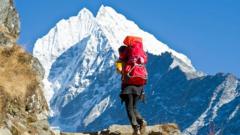Nepal's tourism sector has introduced an initiative to eliminate climbing fees for 97 picturesque peaks located in the country's Karnali and Sudurpaschim provinces. This strategic move aims to draw attention and visitors to regions that have historically been overlooked due to difficult access. As Everest experiences booming popularity, with climbing permit fees increasing to $15,000 this coming September, the government hopes to disperse some of that interest toward less-explored mountains.
In 2022, climbing fees generated $5.9 million, with Everest contributing over 75% of that income. The newly accessible peaks range from 5,970 meters (19,590 feet) to 7,132 meters in height and are located in some of Nepal's poorest and least developed areas. Himal Gautam, the director of Nepal’s Tourism Department, expressed optimism that this initiative would ignite local economies and create job opportunities through tourism.
Despite this promising outlook, the success of this policy hinges on improvements in infrastructure and transportation to these remote sites, as well as the communities' capacity to handle an increase in tourist activity. Historical data shows low interest in these 97 peaks, with only 68 climbing permits issued in the past two years; in sharp contrast to the 421 for Everest in 2024. As discussions continue regarding limiting Everest's climbing permits due to capacity concerns and a new legislative requirement for climbers to have prior experience at higher elevations, the government might be setting the stage for these lesser-explored mountains to become vital training grounds for aspiring climbers.
In 2022, climbing fees generated $5.9 million, with Everest contributing over 75% of that income. The newly accessible peaks range from 5,970 meters (19,590 feet) to 7,132 meters in height and are located in some of Nepal's poorest and least developed areas. Himal Gautam, the director of Nepal’s Tourism Department, expressed optimism that this initiative would ignite local economies and create job opportunities through tourism.
Despite this promising outlook, the success of this policy hinges on improvements in infrastructure and transportation to these remote sites, as well as the communities' capacity to handle an increase in tourist activity. Historical data shows low interest in these 97 peaks, with only 68 climbing permits issued in the past two years; in sharp contrast to the 421 for Everest in 2024. As discussions continue regarding limiting Everest's climbing permits due to capacity concerns and a new legislative requirement for climbers to have prior experience at higher elevations, the government might be setting the stage for these lesser-explored mountains to become vital training grounds for aspiring climbers.



















